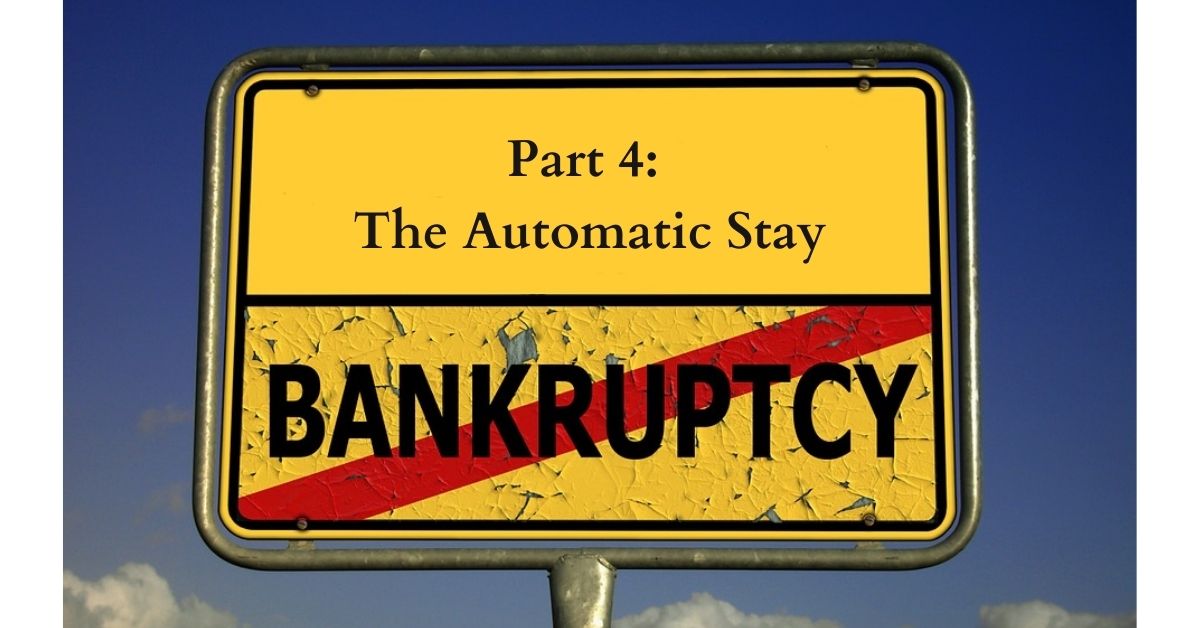Condominiums, Homeowners’ Associations and Bankruptcy: The Automatic Stay

In the last installment of the series, I went through some of the terms that Associations need to know when a Unit Owner files for Bankruptcy. This edition will talk about the “Automatic Stay” and how it affects Creditors like an Association. The first thing to remember is that Bankruptcy is a way to allow people who have debts to get a fresh start. The Automatic Stay gives Debtors some cooling off time. It is a period where Debtors do not have to worry about anyone trying to collect against them.
How Does an Automatic Stay Limit Collections?
When someone files for Bankruptcy, they automatically get protected by an Automatic Stay. Basically, the Automatic Stay stops all actions against the Debtor. The Automatic Stay prohibits anyone from starting or continuing any kind of legal action against a Debtor that does any of the following:
- Attempts to collect or recover a debt that arose before the Bankruptcy petition was filed
- Brings a claim that could have been brought before the petition was filed
- Enforces any judgment against the Debtor
- Attempts any action that creates, perfects or enforces a lien against the Bankruptcy Estate
- Sets off any debt that a Creditor owes to the Debtor
How Long Does the Automatic Stay Last?
The Automatic Stay starts as soon as a person files for Bankruptcy. It lasts until the Bankruptcy is closed, dismissed or Discharged.
In a Chapter 7 Bankruptcy, the Discharge happens when the Bankruptcy Estate is liquidated or (usually) when the Trustee decides that there are no assets to liquidate.
In a Chapter 13 Bankruptcy, the Discharge happens when all of the payments are made under the Plan. This can mean that an Automatic Stay protects a Unit Owner for more than five years.
What Happens if You Violate the Automatic Stay?
If an Association does something in violation of the Automatic Stay, it faces severe penalties. The Debtor can collect actual damages, including court costs and attorneys’ fees. A Bankruptcy Court can even award punitive damages against the Association to the Debtor. In my experience, both of these penalties are likely if the Association (or any other Creditor) tries to collect against a Debtor.
First of all, Debtor attorneys are usually on the lookout for any violation of the Automatic Stay. Their jobs are to protect their clients, and the Automatic Stay is one of the ways to do that.
Also, always remember that Bankruptcy exists to protect people who cannot pay their debts. So Bankruptcy Judges will side with the Debtors whenever someone violates the Automatic Stay.
What Can an Association Do to be Safe?
In a Chapter 7 Bankruptcy, the Automatic Stay comes and goes quickly. So the Association should not take any actions to collect assessments until the Bankruptcy is Discharged or dismissed.
In a Chapter 13 Bankruptcy, if the Association needs to take action to collect assessments, it needs to ask the Bankruptcy Court for permission. This permission is called “Relief From Stay” or “RFS.” The Association cannot do anything to collect Pre-petition Debt without getting the Bankruptcy Court’s permission first. And it cannot try to get a judgment on any Post-petition Debt without Court permission (since the judgment affects the Bankruptcy Estate property).
The Association can send out account statements. But if it wants to do anything more than that, it needs to get permission first.
~
In the next blog post, I’ll walk you through the details and procedure of a Chapter 13 Bankruptcy case.
Part I: How Does a Unit Owner Bankruptcy Affect Collections?
Part 3: What is an “Automatic Stay” and Other Terms You Need to Know
